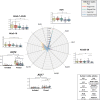Facial representations of complex affective states combining pain and a negative emotion
- PMID: 38777852
- PMCID: PMC11111784
- DOI: 10.1038/s41598-024-62423-2
Facial representations of complex affective states combining pain and a negative emotion
Abstract
Pain is rarely communicated alone, as it is often accompanied by emotions such as anger or sadness. Communicating these affective states involves shared representations. However, how an individual conceptually represents these combined states must first be tested. The objective of this study was to measure the interaction between pain and negative emotions on two types of facial representations of these states, namely visual (i.e., interactive virtual agents; VAs) and sensorimotor (i.e., one's production of facial configurations). Twenty-eight participants (15 women) read short written scenarios involving only pain or a combined experience of pain and a negative emotion (anger, disgust, fear, or sadness). They produced facial configurations representing these experiences on the faces of the VAs and on their face (own production or imitation of VAs). The results suggest that affective states related to a direct threat to the body (i.e., anger, disgust, and pain) share a similar facial representation, while those that present no immediate danger (i.e., fear and sadness) differ. Although visual and sensorimotor representations of these states provide congruent affective information, they are differently influenced by factors associated with the communication cycle. These findings contribute to our understanding of pain communication in different affective contexts.
© 2024. The Author(s).
Conflict of interest statement
The authors declare no competing interests.
Figures







References
-
- Craig AD. Interoception and emotion: A neuroanatomical perspective. In: Barrett LF, Haviland-Jones JM, Lewis M, editors. Handbook of Emotions. The Guilford Press; 2016. pp. 215–234.
-
- Rhudy JL. Emotional modulation of pain. In: Mustafa al Absi M, Flaten MA, editors. The Neuroscience of Pain, Stress, and Emotion: Psychological and Clinical Implications. Academic Press; 2016. pp. 51–75.
-
- Williams ACDC. Facial expression of pain: An evolutionary account. Behav. Brain Sci. 2002;25:439–455. - PubMed
MeSH terms
Grants and funding
LinkOut - more resources
Full Text Sources
Medical

